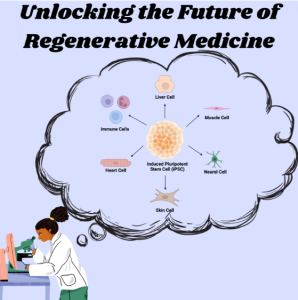Unlocking the Future of Regenerative Medicine
By Ariane Tsai, C2ST Intern, University of Illinois Urbana-Champaign, Institute for Genomic Biology
Regenerative medicine and stem cell therapy. We see these buzzwords when discussing the current advances in modern medicine. But where did it all begin? Stem cell research stretches back to the mid-20th century when researchers observed the regenerative capabilities of organs. This led to the hypothesis that cells may be able to become different cell types. For the next 50 years, scientists continued to make breakthroughs. They discovered that there are cells capable of becoming other cells (i.e., differentiate). Thus, they named the cells with the ability to differentiate and self-renew “stem cells.”

In the late 1990s, a groundbreaking moment occurred when scientists isolated a nucleus from a somatic cell (i.e., a non-dividing cell) and transferred it into an egg cell without a nucleus.1 The resulting embryo, now carrying the donor cell’s genetic information, was implanted into a surrogate sheep. On July 5, 1996, a sheep with the same genetic material as the donor sheep was born. They named the sheep Dolly, and the event marked the first example of cloning.
After Dolly the sheep was born, we knew it was possible to take an adult cell and “reprogram” it to behave like a fertilized egg. This discovery sparked more interest in the concept of cellular reprogramming. Soon after, scientists successfully isolated both mouse and human embryonic stem cells, which opened new doors for stem cell research and its role in regenerative medicine.
However, the use of embryonic stem cells was met with great controversy. To obtain embryonic stem cells, the procedure called for the destruction of an embryo. The ethical and safety concerns that arise from using these cells to conduct research were tremendous. Thus, there was a strong push to find a way to find a substitute for embryonic stem cells.
In June 2006, Shinya Yamanaka and his post-doctoral researcher Kazutoshi Takahashi walked into the International Society for Stem Cell Research annual meeting. They described their efforts to take skin cells from adult mice and turn them back into stem cells by introducing four selected genes. Like embryonic stem cells, these cells can self-renew and differentiate into all cell types in the body.2 The room was stunned, and Yamanaka was met with a myriad of emotions: excitement, skepticism, and curiosity. Many thought that the data presented was too good to be true. If what they presented was real, Yamanaka would have revolutionized the field of biology and pushed the boundaries of what we can do as scientists.
Sure enough, with one more year of research, the team successfully did the same thing with human skin cells and turned them back into stem cells. They named these cells “induced pluripotent stem cells (iPSCs),” signifying their ability to maintain pluripotency (i.e., the ability to turn into all types of cells) after the incorporation of the four reprogramming factors.
The discovery of iPSCs garnered international attention, with many labs attempting (and succeeding) to replicate their work. With his significant contribution, Yamanaka was awarded half of the Nobel Prize in Physiology or Medicine in 2012. Now, iPSCs have become an important tool for modeling and investigating human disease.
Despite these successes, more work still needs to be done. For example, one out of 10,000 somatic cells were successfully reprogrammed to form iPSCs in the original paper. Additionally, two of the genes inserted are known as oncogenes, which can cause cancer.3 These challenges still need to be addressed for iPSCs to go beyond disease modeling and have a therapeutic effect. Nevertheless, the discovery of iPSCs has transformed stem cell research, offering scientists new possibilities in studying human diseases. The future of stem cell research remains promising, with iPSCs paving the way for future medical marvels and breakthroughs.
References: